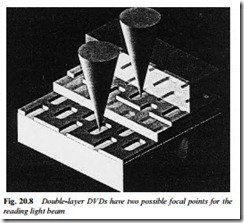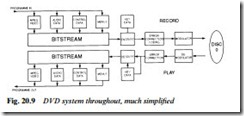DVD PLAYERS
A relatively recent development, in terms of video disc evolution, is DVD (Digital Video Disc). While this system incorporates servo- mechanisms and laser-reading techniques similar to those in audio CD and LDV players, the rest of its design, in terms of both hardware and software, owes more to computer techniques than to conventional tape and disc programme-storage systems.
A DVD disc is the same size as an audio CD: 12 cm diameter and 1.2 mm thick. In both cases the programme data is stored in the form of a spiral of microscopic pits in the surface of the disc and is read off by a laser beam. The DVD, however, can carry a great deal more data than a conventional CD, primarily because the pits are smaller and closer together. The pit length for a DVD is 0.4 micron, and the track pitch 0.74 micron. To permit these tiny pits to be reliably read, the scanning light is a red laser whose light wavelength is shorter at 640 nm than the 780 nm of CD and LD types, see Fig. 20.7. The result is that the disc can store 4.7 Gbytes of information, which is roughly seven times the capacity of a CD, and can thus offer a playing time – using a MPEG-2 data-compression system of the sort described in Chapter 12 – of over two hours of high-quality (horizontal resolution greater than 500 lines) pictures, plus multi- channel digital surround sound. Also available are facilities for eight language channels and up to 32 subtitling tracks.
Disc capacity
A standard DVD disc is single sided like a CD or LDV, but because it is made from two 0.6 mm discs bonded back to back the format specification provides for a double-sided system (flip-over disc or double-side-play machine) and for a dual-layer disc, in which the two substrates of which the disc is made are both stamped with pit spirals, selected during play by moving the objective lens as necessary to focus on the required layer: Fig. 20.8 shows the principle. Combining the double-side and dual-layer techniques offers a ‘X4’ play facility on a single disc, with a capacity of 17 Gbyte/8 hours’ picture/sound replay.
Regional coding and encryption
Because the DVD format has no constrictions in regard to scanning standards or colour-encoding systems the software copyright hold- ers (mainly film/movie companies) have made it a condition of their participation that discs and players are regionally coded. This ensures that software release around the world is controlled by them in a sequence which maximises profits from viewers and cinema-goers. The regions are shown in Table 20.2, and a disc released in one region
will not work in a player bought in another region: a ‘flag’ is encoded onto the disc which prevents replay unless the firmware in the player recognises and permits it.
Copy protection, too, is important to film companies who produce what amounts to digital master copies of films at retail prices, with playing rights confined to the household of the individual buyer: it must be made impossible to copy them onto tape or disc. This is achieved by a DES (Disc Encryption System) whereby the bit- stream, containing interleaved video, audio and control data, is encrypted according to a secure 40-bit ‘random-key’ code. When the disc is played it is interrogated for an anti-copy flag – not all discs will carry this – and the player uses a key to decode the data. Copying is prevented by disruption of the colour subcarrier in the (e.g. PAL) analogue encoder or by blanking of the RGB output signals.
DVD signal processing
Fig. 20.9 outlines the stages involved in the DVD record and replay systems. The incoming video and audio signals are A-D converted, compressed and protected against data corruption and dropout. The vision signal compression system uses a variable-redundancy technique, depending on the programme material itself and the degree of quality required by the programme producer and the viewer – it varies from 1 to 10 Mbit/s, with a typical average of 4.5 Mbit/s. Electronically generated menus, subtitles and control data are added to make up a composite bitstream which then undergoes encryption according to the 40-bit key mentioned above. Further error protec- tion is given to the data in the form of Reed−Solomon coding before modulation into an 8–16 form which governs the length of the pits impressed into the master disc from which the stamping die will be made. The disc speed varies throughout record and replay to give a scanning rate of 4 metres/sec in CLV mode.
In replay the data pulses coming from the photodiodes in the reading laser assembly are demodulated and the tracking/focus feedback signals extracted from them. The following processes reciprocate
those carried out on the signal during the conversion and recording stages.
DVD features
The vision signal carried on DVD can have 4:3 aspect ratio, but is usually 16:9; some discs carry 16:9 on one side and a 4:3 ‘pan and scan’ version of the same film on the reverse side. It is possible to produce a DVD disc with many hours’ running time at lower picture quality, acceptable for some types of programmes.
With-picture sound is encoded to MPEG-2 audio standard for Europe and to Dolby Digital (also known as AC-3) for the USA. Both sound systems are 5.1-channel ‘multi’ types, with a total of 6 audio streams: left front, right front, centre front (primarily for dialogue), left surround/rear, right surround/rear, and subwoofer (‘super-bass’). Unlike the matrixed surround system described in the next chapter, each of these has its own dedicated slot in the datastream to ensure good bandwidth and S/N ratio for each audio channel: the result is sharply ‘focused’ sound and a much closer approach to cinema sound reproduction. Up to eight different languages can be selected from one disc. There is also an audio- only format for DVD (PCM audio) which is capable of 16-, 20- or 24-bit sound with 48 kHz or 96 kHz sampling for performance beyond that of audio CD – for those with equipment and ears capable of appreciating it!
A DVD disc can offer up to 32 subtitle tracks in different languages, and their selection for display is independent of the audio language. This is beneficial to viewers with hearing difficulties.
Also within the DVD specifications is a disc format for the storage of computer data (DVD-ROM, with a complex copy-protection system) also the operation of interactive games and multi-media material. The DVD system makes provision for the use of a home-recording system with DV–R (3.9 G capacity) and DV-RAM (2.6 G), when disc recording will become a serious rival to tape systems for home use.
Player features
DVD players have an ability to play audio CDs by means of an optical lens with dual-focus capability. Parental control of viewing and features like aspect-ratio conversion are possible with a suitably encoded disc, along with ‘chapter search’ using off-disc data codes. Certain players offer additional features like picture zoom, optical audio-out ports and dynamic sound range compression, depending on model and price.



